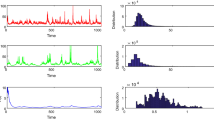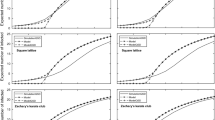Abstract
We introduce random fluctuations on contact and recovery rates in deterministic SIR model with disease deaths in nonparametric manner and obtain stochastic counterparts with general diffusion coefficients (functional contact and recovery rates).
The introduced stochastic model has functional diffusion coefficients which contains arbitrary local Lipschitz-continuous functions \(F_i\)’s defined on
In this paper we prove the global existence of a unique strong solution and discuss stochastic asymptotic stability of disease free and endemic equilibria of the model and visualize our results with some simulations to confirm them.





Similar content being viewed by others
References
Allen, E.J.: Stochastic differential equations and persistence time for two interacting populations. Dyn. Contin. Discrete Impuls. Syst. 5, 271–281 (1999)
Allen, L.J.S.: An Introduction to Stochastic Processes with Applications to Biology. Prentice Hall, New Jersey (2003)
Arnold, L.: Stochastic Differential Equations: Theory and Applications. Wiley, New York (1974)
Beretta, E., Kuang, Y.: Modeling and analysis of a marine bacteriophage infection. Math. Biosci. 149, 57–76 (1998)
Beretta, E., Kolmanovskii, V., Shaikhet, L.: On the general structure of epidemic systems. Global asymptotic stability. Comput. Math. Appl. Part A 12, 677–694 (1986)
Beretta, E., Kolmanovskii, V., Shaikhet, L.: Stability of epidemic model with time delays influenced by stochastic perturbations. Math. Comput. Simul. 45(3–4), 269–277 (1998)
Brauer, F., van den Driessche, P., Wu, J. (eds.): Mathematical Epidemiology, Lecture Notes in Mathematics, vol. 1945. Springer, New York (2008)
Carletti, M.: On the stability properties of a stochastic model for phage-bacteria interaction in open marine environment. Math. Biosci. 175, 117–131 (2002)
Dalal, N., Greenhalgh, D., Mao, X.: A stochastic model of AIDS and condom use. J. Math. Anal. Appl. 325(1), 36–53 (2007)
Dalal, N., Greenhalgh, D., Mao, X.: A stochastic model for internal HIV dynamics. J. Math. Anal. Appl. 341(2), 1084–1101 (2008)
Gard, T.C.: Introduction to Stochastic Differential Equations. Marcel Dekker, New York and Basel (1998)
Gray, A., Greenhalgh, D., Hu, L., Mao, X., Pan, J.: A stochastic differential equation SIS epidemic model. SIAM J. Appl. Math. 71(3), 876–902 (2011)
Imhofa, L., Walcher, S.: Exclusion and persistence in deterministic and stochastic chemostat models. J. Differ. Equ. 217, 26–53 (2005)
Jianga, D., Yua, J., Jia, C., Shia, N.: Asymptotic behavior of global positive solution to a stochastic SIR model. Math. Comput. Model. 54(1:2), 221–232 (2011)
Khas’minskiĭ, R.: Stochastic Stability of Differential Equations. Sijthoff & Noordhoff, Alpen (1980)
Lahrouz, A., Omari, L., Kiouach, D.: Global analysis of a deterministic and stochastic nonlinear SIRS epidemic model. Nonlinear Anal. Model. Control 16(1), 59–76 (2011)
Lahrouz, A., Omari, L., Kiouach, D., Belmaati, A.: Deterministic and stochastic stability of a mathematical model of smoking. Stat. Probab. Lett. 81(8), 1276–1284 (2011)
Schurz, H.: Moment attractivity, stability and contractivity exponents of stochastic dynamical systems. Discrete Contin. Dyn. Syst. 7(3), 487–515 (2001)
Schurz, H.: On moment-dissipative stochastic dynamical systems. Dynam. Syst. Appl. 10(1), 11–44 (2001)
Schurz, H.: Modelling, analysis and discretization of stochastic logistic equations. Int. J. Numer. Anal. Model. 4(2), 180–199 (2007)
Tornatore, E., Buccellato, S.M., Vetro, P.: Stability of a stochastic SIR system. Phys. A 354, 111–126 (2005)
Author information
Authors and Affiliations
Corresponding author
Appendices
Appendix 1: Existence of a Unique Markovian, Continuous Time Solution
Consider the d-dimensional stochastic differential equation of the form
with an initial value \(X(t_0)=X_0,~~ t_0 \le t \le T < \infty \) where \(\displaystyle f:{\mathbb {R}}^{d} \times [t_0,T] \rightarrow {\mathbb {R}}^{d}\) and \(\displaystyle g:{\mathbb {R}}^{d} \times [t_0,T] \rightarrow {\mathbb {R}}^{d \times m}\) are Borel measurable, \(\displaystyle W=\{W(t)\}_{t\ge t_0}\) is an \(\displaystyle {\mathbb {R}}^m\)-valued Wiener process, and \(X_0\) is an \(\displaystyle {\mathbb {R}}^{d}\)-valued random variable.
The infinitesimal generator \(\mathbf {{\mathcal {L}}}\) associated with the SDE (23) is given by
Theorem 4
(\({\mathbb {D}}\) -invariance) (Khas’minskiĭ [15] as appears in [11]) Let \({\mathbb {D}}\) and \({\mathbb {D}}_n\) be open sets in \({\mathbb {R}}^d\) with
and suppose \(f\) and \(g\) satisfy the existence and uniqueness conditions for solutions of (23) on each set \(\{(t,x): t>t_0,\, x \in {\mathbb {D}}_n\}\). Suppose there is a nonnegative continuous function \(V: {\mathbb {D}}\times [t_0,T]\rightarrow {\mathbb {R}}_+\) with continuous partial derivatives and satisfying \({\mathcal {L}}V \le c~V\) for some positive constant \(c\) and \(t>t_0,\, x \in {\mathbb {D}}\). If also,
then, for any \(X_0\) independent of \(\sigma (W)\) such that \({\mathbb {P}}(X_0 \in {\mathbb {D}})=1,\) there is a unique Markovian, continuous time solution \(X\) of (23) with \(X(0)=X_0\), and \(X(t) \in {\mathbb {D}}\) for all \(t>0\) (a.s.).
Appendix 2: Stability of Equilibria
Consider the d-dimensional SDE
Assume that \(f\) and \(g\) satisfy, in addition to the existence and uniqueness assumptions, \(f(x^*,t)=0\) and \(g(x^*,t)=0\) for equilibrium solution \(x^*\) for \(t \ge t_0\). Furthermore, let’s assume that \(x_0\) be a non-random constant with probability 1.
Definition 1
The equilibrium solution \(x^*\) of the SDE (25) is stochastically stable (stable in probability) if for every \(\epsilon > 0\) and \(s \ge t_0\)
where \(X_{s,x_0}(t)\) denotes the solution of (25) satisfying \(X(s)=x_0\) at time \(t \ge s\).
Definition 2
The equilibrium solution \(x^*\) of the SDE (25) is said to be stochastically asymptotically stable if it is stochastically stable and
Definition 3
The equilibrium solution \(x^*\) of the SDE (25) is said to be globally stochastically asymptotically stable if it is stochastically stable and for every \(x_0\) and every \(s\)
Theorem 5
(Arnold [3]) Assume that \(f\) and \(g\) satisfy the existence and uniqueness assumptions and they have continuous coefficients with respect to \(t\).
-
(i)
Suppose that there exist a positive definite function \(V~\in ~C^{2,1}\big (U_h \times [t_0,\infty )\big )\), where \(U_h=\{x \in {\mathbb {R}}^d:\Vert x-x^*\Vert <h\}\) for \(h>0\), such that
$$\begin{aligned} \displaystyle \mathrm{ for \, all }~t \ge t_0, ~~~ x \in U_h: ~~~ {\mathcal {L}}V(x,t) \le 0. \end{aligned}$$(29)Then, the equilibrium solution \(x^*\) of (25) is stochastically stable.
-
(ii)
If, in addition, \(V\) is decrescent (there exists a positive definite function \(V_1\) such that \(V(x,t)\le V_1(x)\) for all \(x \in U_h\)) and \({\mathcal {L}}V(x,t)\) is negative definite, then the equilibrium solution \(x^*\) is stochastically asymptotically stable.
-
(iii)
If the assumptions of part ii) hold for a radially unbounded function \(V~\in ~C^{2,1}\big ({\mathbb {R}}^d \times [t_0,\infty )\big )\) defined everywhere then the equilibrium solution \(x^*\) is globally stochastically asymptotically stable.
Rights and permissions
About this article
Cite this article
Schurz, H., Tosun, K. Stochastic Asymptotic Stability of SIR Model with Variable Diffusion Rates. J Dyn Diff Equat 27, 69–82 (2015). https://doi.org/10.1007/s10884-014-9415-9
Received:
Revised:
Published:
Issue Date:
DOI: https://doi.org/10.1007/s10884-014-9415-9




